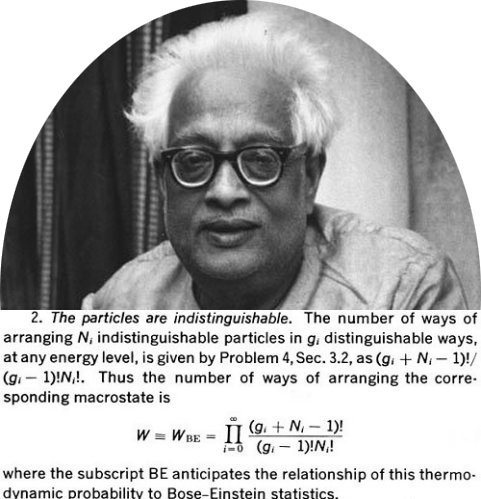Satyendranath Bose
Today, Satyendranath Bose. The University of Houston's College of Engineering presents this series about the machines that make our civilization run, and the people whose ingenuity created them.
If you ever studied quantum mechanics, you know about Bose-Einstein statistics. So, first some physics: We have two different ways to know the behavior of matter -- like a gas or a crystal lattice. We can go to the lab and measure its properties, or sit at a desk and calculate how its atoms or molecules cause it to behave.
To do the calculation, we write a description of all possible arrangements of the atoms, then we use math to select the most probable one. When we have a huge population of atoms, the most probable arrangement is just about certain to occur.
We began doing those calculations in the late nineteenth century. Then quantum mechanics complicated matters. We ran into particular trouble with arrangements of identical atoms, because it's meaningless to talk about interchanging them.
Here Satyendranath Bose enters our story. He was born in 1894 in East Bengal, now Bangladesh. He was very bright. He compensated for poor eyesight by developing a prodigious memory. In 1924 Bose was on the physics faculty at the University of Dacca, thinking about the exciting confusion swirling about quantum theory.
By then, Einstein's and Planck's quantum mechanics, each gave valid results, but they appeared to conflict with one another. Bose realized that the problem lay in the indistinguishability of of photons. So he wrote a short paper and sent it off to Einstein.
Einstein carried on a vast correspondence with the whole spec-trum of brilliance to crankery. He might've shrugged Bose off, but the title, Planck's Law and the Light-Quantum-Hypothesis, caught his eye. And the paper proved to be brilliant.
Bose had shown how Planck's and Einstein's work were consistent with one another. He'd cut the Gordian Knot of quantum theory -- broken the logjam. Einstein immediately translated it into German and saw that it was published. Bose went to Europe to work as part of the group that now put quantum mechanics on solid footing.
But Bose was passionately Indian. After two years, he went back home to teach physics. He held high posts at Dacca and the University of Calcutta. He was finally made Chancellor of a university that'd been founded by Nobel Laureate poet Tagore, whom he admired immensely.
Bose strongly opposed the caste system and prevailing forms of ostentation. He was a fine musician. He was a great conversationalist. He was also a true populist, enormously beloved by his countrymen. When he died, whether or not they'd ever heard of quantum mechanics, they lined the streets to grieve his passing.
Tagore might as well have been expressing the contradictory subtlety of Bose himself, in a wonderfully elegant two-line poem,
What you are you do not see.
What you see -- that you are not.
Tagore speaks in the same clean minimalism that marked Bose's physics, his dealings with the world -- his entire life.
I'm John Lienhard, at the University of Houston, where we're interested in the way inventive minds work.
W. A. Blanpied, Bose, Satyendranath. Dictionary of Scientific Biography (C.C. Gilespie, ed.) New York: Charles Scribner's Sons, 1970-1980.
The Tagore poem (above) is titled Unmanifest. See: D. Chopra, On the Shores of Eternity. New York: Harmony Books, 1999, pg. 51.
C. L. Tien and J. H. Lienhard, Statistical Thermodynamics, New York: Hemisphere Publishing Corp., 1979, Section 6.1.
